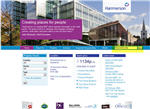Do you think that having a search facility on your site is a fairly standard best practice these days?
I do.
And yet 17% of the FTSE 100 do not have a search box (or link to a search page) on their home page. Why is this?
Do you need a search function?
In short, yes, you do. Many people prefer to use the search function to navigate, rather than guessing which of the navigation buttons will lead to the information they want. And if a visitor gets lost in your site, then the search function can be invaluable in helping them get started again.
A few of the FTSE 100 choose to use a link to a search page, rather than a search box.
Why would you do this? Surely it is better for the visitor to simply type in what they are looking for, and click to search, rather than go to another page, type in their search request and click to search?
But most of these companies with links to a search page offer further choices at the search page – mostly the option to search part of the site only, such as the Investor section, narrowing down the search.
Enhancing the search options for the visitor must be helpful and therefore a Good Thing. Some companies, such as AstraZeneca and BHP Billiton, go a step further, and provide both the search box on the home page and a link to a dedicated search page, from which a complex search can be initiated if desired, and this, I think, may be the best outcome if you feel your site needs an advanced search function.
(I’ve highlighted the search function on these screenshots – otherwise it might take you a few seconds to find some of them).
Where should the search box be?
Most of the 83% who do include a search box on the home page put it at the top right corner, above the main navigation. 55 out of 100 do this, and there are three examples on the right.
But this isn’t the only solution chosen.
2 companies put the search in the bottom site services bar – where you would normally find the privacy, legal and disclaimer links. My own view is that this ignores the importance of the search function for the visitor, for whom the ability to search is much more important than these privacy/legal pages. Yes, these pages are important – but for the company, rather than for the visitor.
At least Kingfisher distinguishes the search function from the rest of the site services bar at the bottom …
 16 companies include the Search facility in the main navigation, as Hammerson do.
16 companies include the Search facility in the main navigation, as Hammerson do.
A couple of companies have a slightly unconventional solution. Aviva places the search under the left hand navigation. Intercontinental Hotels and Rolls-Royce both integrate the search facility with sidebar navigation – and then place this navigation on the right hand side of the page.
 |  |
| Intercontinental Hotels | Rolls-Royce |
Overall, though – and not remotely surprising, if you’ve spent any time at all looking at websites – the most common place to put the search function is somewhere towards the top right hand corner. Usually at the very top and the very right. Since this is the most common place to put it, it has become the best place, because that is where your visitors will look for it.
Is it always the case that what is usually done is the best way to do something?
No, of course not – but I think it is here, at least until someone comes up with something entirely new that is easy, memorable, and works across browsers and platforms. The usability benefits of making the search function easy to find are huge.
Lucy is Editor at Corporate Eye







